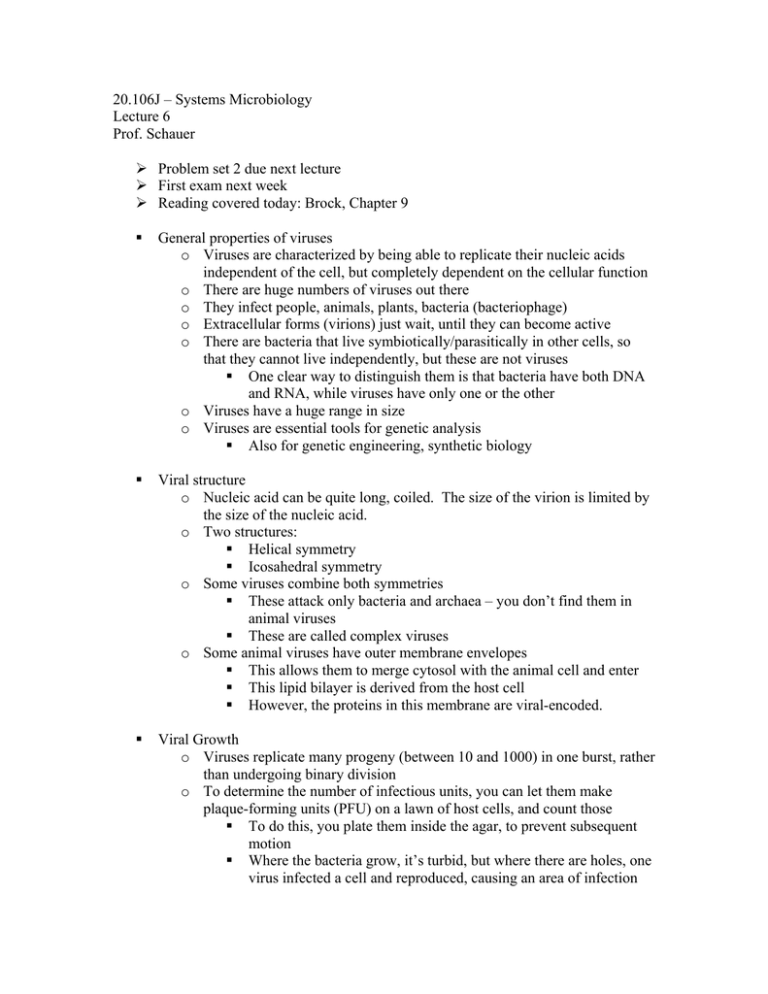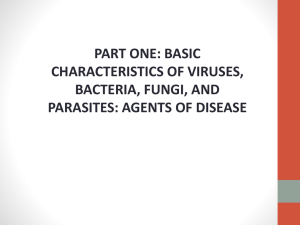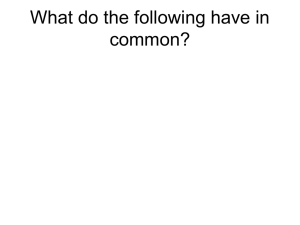20.106J – Systems Microbiology Lecture 6 Prof. Schauer
advertisement

20.106J – Systems Microbiology Lecture 6 Prof. Schauer ¾ Problem set 2 due next lecture ¾ First exam next week ¾ Reading covered today: Brock, Chapter 9 General properties of viruses o Viruses are characterized by being able to replicate their nucleic acids independent of the cell, but completely dependent on the cellular function o There are huge numbers of viruses out there o They infect people, animals, plants, bacteria (bacteriophage) o Extracellular forms (virions) just wait, until they can become active o There are bacteria that live symbiotically/parasitically in other cells, so that they cannot live independently, but these are not viruses One clear way to distinguish them is that bacteria have both DNA and RNA, while viruses have only one or the other o Viruses have a huge range in size o Viruses are essential tools for genetic analysis Also for genetic engineering, synthetic biology Viral structure o Nucleic acid can be quite long, coiled. The size of the virion is limited by the size of the nucleic acid. o Two structures: Helical symmetry Icosahedral symmetry o Some viruses combine both symmetries These attack only bacteria and archaea – you don’t find them in animal viruses These are called complex viruses o Some animal viruses have outer membrane envelopes This allows them to merge cytosol with the animal cell and enter This lipid bilayer is derived from the host cell However, the proteins in this membrane are viral-encoded. Viral Growth o Viruses replicate many progeny (between 10 and 1000) in one burst, rather than undergoing binary division o To determine the number of infectious units, you can let them make plaque-forming units (PFU) on a lawn of host cells, and count those To do this, you plate them inside the agar, to prevent subsequent motion Where the bacteria grow, it’s turbid, but where there are holes, one virus infected a cell and reproduced, causing an area of infection This replication period eventually stops, because the viruses depend on cellular metabolism, and once they use up their nutrients, the bacteria aren’t growing fast enough for the virus to be able to use them Demonstration: Prof. Schauer shows the class an agar plate with PFUs o There’s a distinction between what you can see and what can grow: this is called plating efficiency. The actual number that you can count will be different from the total number PFU Plating Efficiency = Total Virions This is complicated with growing animal cells Animal virus methods o Some viruses will be very picky about what kind of cells they will grow on Example: Hepatitis B o Where possible, people will use continuous culture cell lines o These cells will grow into a confluent lawn with their own extracellular matrix. Then you pour out the liquid, and replace it with agarose, to prevent the virus from moving around. o You can do progressive dilutions to determine number o Magnified photo: cells infected and uninfected by viruses Viral replication o Diagram: virion enters a cell, replicates, and lyses the cell o Key terms: eclipse, maturation, latent period, one-step growth, burst size Attachment and Penetration o Diagram: bacteriophage entering a cell, nucleic acids injected o Animal cells have a variety of defenses: Interferons The fever we run Restriction endonucleases – sense particular DNA sequences and chew them up • However, semiconservative replication can protect against these endonucleases Viral replication: nucleic acids and protein o Single stranded vs. double stranded, DNA vs. RNA o In single-stranded DNA viruses, the negative DNA strand only exists during the latent period, when it’s replicating o Messenger RNA enzyme doesn’t exist in the cell – the virus has to bring it along in order to be expressed Sometimes instead the virus’s RNA can act directly as its own mRNA Virulent bacteriophage o Viruses are a great way to study normal cellular processes – that’s why we’re so interested o There are huge books on this o T4 (best studied) linear genome, double-stranded, circularly permutated (meaning that the beginning of the genome is repeated again at the end of the genome). The ends are always duplicates, but what part gets duplicated is arbitrary.





